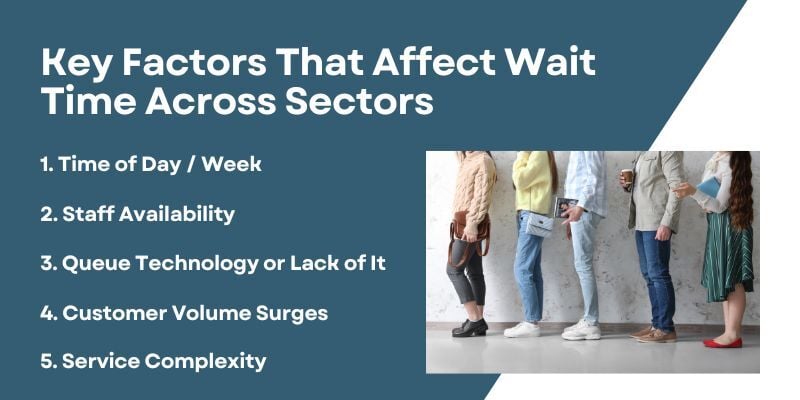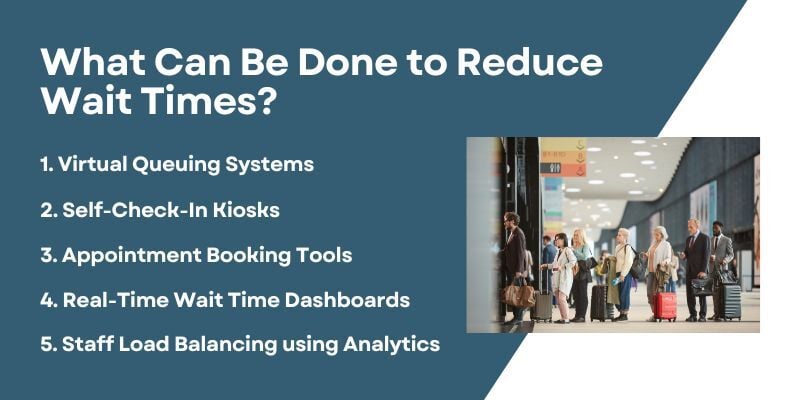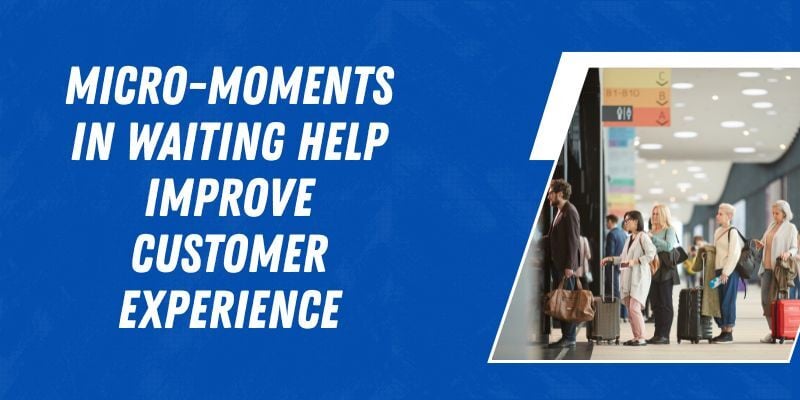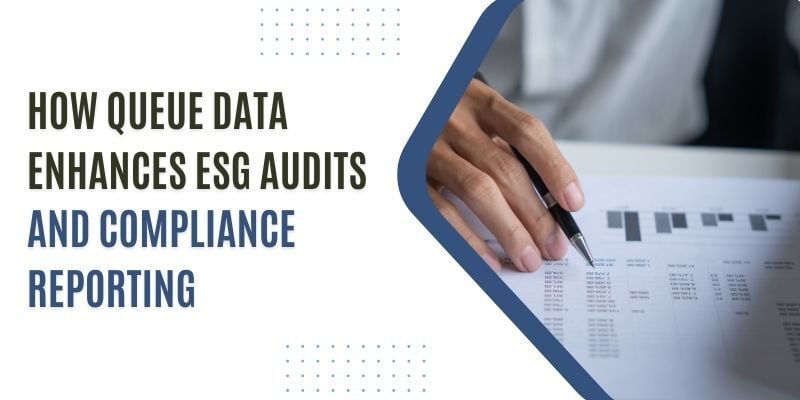You take a number at the bank, glance at the screen, and see 42 people ahead. At the clinic, you show up early but still end up waiting over an hour. In retail, you’re stuck behind a slow-moving return line, wondering if it’s even worth staying.
These moments aren’t rare — they happen every day. And they carry more weight than most businesses realize.
The average wait time has a direct impact on customer satisfaction, operational efficiency, and revenue. Long lines aren’t just an inconvenience. They signal friction that drives people away. Even a few extra minutes of delay can lead to walkouts, bad reviews, and lost loyalty.
This blog explores average wait times in banks, hospitals, and retail, why they persist, and how leading organizations are tackling them with digital tools like queue management systems and appointment booking.
Why Average Wait Time Matters

Long wait times aren’t just annoying; they’re directly tied to business outcomes across sectors.
In banking, long queues during peak hours often lead to queue abandonment, especially for high-value services like mortgage consultations or account upgrades. Customers may opt for faster, digital-first banks instead, resulting in reduced branch ROI.
In healthcare, delays in outpatient clinics or registration desks affect patient flow, reduce clinician productivity, and negatively impact patient satisfaction scores, such as HCAHPS ratings in the US. Long waits also increase no-show rates for follow-ups.
In retail, average customer wait times at billing or returns counters significantly impact walkouts. A slow checkout process can shrink basket size and damage brand perception, especially when competitors offer faster alternatives.
According to PwC, 32% of all customers would stop doing business with a brand they loved after a single bad experience. In sectors where timing is crucial, a single delay can be enough to turn customers away for good.
This is where queue management systems create measurable value. Tools like virtual queuing, mobile alerts, and smart scheduling help optimize wait times by redistributing foot traffic, reducing crowding, and keeping customers informed throughout their journey.
Average Wait Times in Banks
In many markets, customers typically wait between 5 and 15 minutes before being met by a service representative. High-traffic urban branches often see longer lines, especially during lunch hours or when staff is limited.
Complex services, such as credit or loan applications and new account setups, often incur longer delays, especially because documentation checks and ID verification steps slow down the processing.
General Statistics and Trends
A study conducted on banking service delivery found the average queue-only wait time for transactions was 14.55 minutes in a private bank setting, highlighting a common pain point across many branches.
Processes such as ID checks, document reviews, and KYC formalities extend wait times further, especially for services other than basic transactions.
Impact on Customer Satisfaction
Wait times longer than 10 minutes significantly damage satisfaction and trust in banking services.
According to the 2023 KPMG West Africa Banking Industry Customer Experience Survey, approximately 14% of respondents stated that slow turnaround times and limited access to loans prompted them to consider switching their primary bank.
This high queue abandonment rate highlights customers’ intolerance for inefficiency and reinforces perceived inadequacies in service delivery.
As Warren Buffett puts it, “It takes twenty years to build a reputation and five minutes to ruin it.”
Long wait times don’t just delay service. They weaken customer confidence, reduce loyalty, and increase churn across financial institutions.
What Banks Are Doing to Improve It
To reduce wait times, many banks now use queue management systems that let customers join queues remotely via SMS, mobile apps, or online portals.
Some branches have also introduced express counters for quick transactions or VIP clients, while others separate routine teller services from more complex tasks.
This shift isn’t just about reducing lines — it’s about creating smoother and more predictable service flows across departments.
For example, Banorte, one of Mexico’s largest banks, upgraded customer service across 1,000+ branches by deploying Wavetec’s queue management system.
With daily footfall reaching up to 800 customers in larger branches, the bank needed a solution to reduce waiting times and streamline in-branch flow.
Customers now check in via self-service kiosks that read their bank cards and issue prioritized tickets based on account type, allowing the system to manage queues fairly and efficiently.
Digital signage guides visitors to available counters, while real-time dashboards provide managers with visibility into foot traffic and service KPIs. Staff can then adjust the service flow based on the branch’s level of activity throughout the day.
The result is shorter wait times, smoother branch operations, and a service experience that keeps both high-value clients and regular customers engaged and informed.
Average Wait Times in Hospitals and Clinics
Hospitals and clinics strive to deliver timely care, but patient volumes and limited staffing often result in delays.
Whether in emergency rooms or walk-in clinics, inefficient systems and limited queue visibility continue to be major contributors to longer wait times and service bottlenecks. This is especially true when paper-based check-ins or manual workflows are still in use.
Emergency Rooms (ERs)
Emergency departments face unpredictable patient flow and case severity. While triage prioritizes the most critical patients, those with non-urgent needs often wait much longer.
According to a study published in BMC Emergency Medicine, the median ER wait time was 27.5 minutes, though hospitals with higher congestion or staffing issues saw much longer delays.
Weekends, flu season, and holidays further increase pressure on emergency departments. In such scenarios, lengthy wait times in ER units become common, often leading to patient frustration and overcrowded treatment bays.
Walk-in Clinics and General Practitioners
Waits in general practice are shorter on average but highly variable. Most patients spend 20 to 45 minutes waiting, depending on location and scheduling practices. Overbooked time slots, paperwork delays, and unscheduled visits frequently disrupt the clinic’s workflow.
In many clinics, customer wait time data isn’t tracked in real time, making it harder to manage queues or send updates to patients.
Digital check-in systems and automated appointment scheduling are still missing in several smaller practices, despite their potential to reduce friction.
Impact on Patient Outcomes and Satisfaction
Waiting time in hospitals affects more than just convenience — it has real consequences. In the UK, an NHS survey revealed that 70% of patients awaiting treatment reported that delays had a significant impact on their lives.
Among them, 57% reported anxiety or stress, while 38% said their conditions worsened due to long waits. These delays also lead to missed appointments and higher no-show rates.
To combat this, more hospitals are introducing AI to manage hospital queues, provide real-time dashboards, and implement virtual queuing systems, thereby improving flow and reducing perceived wait times.
Average Wait Times in Retail Settings
Efficient checkout lines directly affect sales. When service slows, shoppers often walk away without making a purchase, and retailers lose revenue. Whether it’s a department store or boutique, poor queue management can impact foot traffic, conversion rates, and brand loyalty.
Department Stores & Grocery Chains
In most stores, customers wait 5 to 10 minutes at checkout. But during sales, weekends, or holidays, wait times can stretch past 15 minutes.
When lines spill into walkways or entry points, many shoppers avoid entering or abandon full carts before checkout. These missed opportunities stack up quickly, especially during peak periods.
Retailers that manage peak season traffic using queue management systems, such as digital signage, mobile alerts, or overflow lanes, are better equipped to control congestion and preserve conversion rates during rush hours.
Fashion, Cosmetics & Electronics Retail
Luxury brands sometimes use controlled access to create exclusivity, but this model doesn’t translate across the board. In fashion chains, makeup counters, and electronics outlets, slow-moving lines often deter potential buyers.
These stores thrive on quick decisions. If checkout takes too long, shoppers leave or compare prices online instead. In-store friction weakens impulse purchases and increases cart abandonment.
Retailers that focus on reducing retail queue times by adding scan-and-go technology or self-service kiosks often recover those lost sales. Quick, low-contact checkouts help retain customers who value efficiency.
Customer Expectations in Retail
PwC’s Global Consumer Insights Pulse Survey found that 42% of shoppers prefer self-checkout, while 34% want scan-and-go options to speed up their in-store experience.
With the rise of express lanes, mobile payments, and self-service systems, most shoppers now expect to be served within 2–3 minutes. Longer queues, whether visible or anticipated, discourage customers, especially younger ones who prioritize speed and convenience.
Samsung Spain provides a practical example. Faced with increasing service demand and a need to differentiate experiences for premium customers, the brand partnered with Wavetec to implement a full digital queuing system.
Customers can now book appointments online or via WhatsApp and check in at kiosks inside the store. Premium device owners are prioritized automatically, while real-time dashboards help staff manage traffic and reduce bottlenecks.
As a result, Samsung improved wait time efficiency, enhanced customer satisfaction, and ensured GDPR-level data privacy compliance across its retail locations.
Key Factors That Affect Wait Time Across Sectors

Understanding what influences queue length is essential to solving the queuing problem. Across banking, healthcare, and retail, five core factors consistently impact service speed and customer experience.
1. Time of Day/Week
Traffic tends to peak at predictable times:
- Banks see a spike on Monday mornings when customers handle payments, support, and account updates.
- Retail faces pressure on Friday evenings as shoppers head in after work.
- Hospitals and ERs often experience higher volumes on Sunday nights as patients prepare for the week.
Organizations that actively track such footfall trends can adjust staffing or hours to match demand more precisely.
2. Staff Availability
Across sectors, understaffing remains a significant problem, resulting in longer queues. Factors like sick leaves, shift gaps, and employee turnover can slow service delivery at counters, checkouts, and front desks.
Even one missing team member can lead to delays, especially in branches or outlets without cross-trained or on-call backup.
3. Queue Technology or Lack of It
Organizations using digital systems like virtual queuing, SMS check-in, or touchless ticketing reduce both wait perception and physical crowding. These systems enable more efficient service allocation and improve transparency.
Whereas locations still relying on first-come, first-served systems or paper-based sign-ins tend to experience slower flow and more frustrated customers.
4. Customer Volume Surges
Sudden increases in foot traffic, such as during flu season in clinics or peak shopping weeks, can overwhelm systems that are not built for flexibility.
These surges may stem from predictable events or unexpected triggers like weather changes, local festivals, or flash sales. Without proactive queue monitoring, many businesses fail to respond in real-time, leading to growing lines and longer delays.
5. Service Complexity
The nature of the service provided heavily influences wait time:
- Banking: Account openings and loan applications require documentation and compliance checks.
- Healthcare: Pre-op consultations or diagnostic reviews involve multiple stages.
- Retail: Personalized assistance or tech support sessions take longer than basic purchases.
Longer sessions delay everyone else in line, creating a bottleneck even when the overall volume is moderate.
What Can Be Done to Reduce Wait Times?

Long queues aren’t just frustrating; they also affect revenue, reduce staff efficiency, and lower customer satisfaction. In a hospital or retail store, delays during peak hours can lead to walkouts or bottlenecks that disrupt service flow.
Reducing wait times involves speeding up each step, eliminating unnecessary delays, and empowering people to manage their time more effectively with digital tools.
1. Virtual Queuing Systems
Virtual queuing systems allow customers to join a line using their phone, a website, or an on-site kiosk. They receive real-time updates, freeing them from waiting in crowded areas. This reduces lobby congestion, improves flow, and allows staff to serve more people efficiently.
2. Self-Check-In Kiosks
Self-service kiosks let customers check themselves in on arrival using a touchscreen. This speeds up processing and reduces pressure on staff, especially during rush hours in clinics and service branches.
3. Appointment Booking Tools
Online appointment booking tools help spread traffic across the day. With calendar sync, reminders, and easy rescheduling, they cut no-shows and ease walk-in surges. That means better prep for staff and smoother experiences for visitors.
4. Real-Time Wait Time Dashboards
Digital displays or mobile apps showing updated queue times help manage expectations and reduce complaints. These dashboards also help managers identify slowdowns and make quick adjustments to operations.
5. Staff Load Balancing Using Analytics
Queue data shows when and where teams are overwhelmed. Managers can shift staff to busier counters or add support where needed. This improves both service speed and employee focus.
Conclusion
Reducing wait times is not just about technology; but it also improves how services are delivered.
When customers check in quickly, see how long they will wait, and move through a space without confusion, the entire experience improves. Staff can focus better, queues become easier to manage, and operations run more smoothly.
Wavetec helps organizations apply these improvements. From virtual queuing to real-time dashboards, its tools make every visit faster, more efficient, and less stressful for both customers and teams.
BOOK A FREE DEMO





